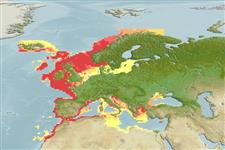Пластиножаберные (акулы и скаты) (sharks and rays) >
Rajiformes (Skates and rays) >
Rajidae (Skates)
Etymology: Leucoraja: Greek, leykos = white + Latin, raja = a fish, Raja sp. (Ref. 45335).
More on author: Linnaeus.
Environment: milieu / climate zone / пределы глубины / distribution range
экология
морской батидемерсальный; пределы глубины 30 - 600 m (Ref. 106604). Deep-water; 72°N - 27°N, 24°W - 34°E
Eastern Atlantic: Murmansk in Russia, Norway, southern Iceland, the Faroes, northern North Sea and Skagerrak to northern Morocco, including western Mediterranean and the Madeira Islands.
Length at first maturity / Size / Вес / Возраст
половая зрелость: Lm ?, range 75 - ? cm
Max length : 120 cm TL самец/пол неопределен; (Ref. 106604); 111.0 cm TL (female)
колючие лучи спинного плавника (общее число) : 0; колючие лучи анального плавника: 0. Snout pronounced, rather pointed; disc rhomboid, with angled outer corners upper surface entirely spinulose, underside prickly on large areas; about 8 thorns usually in a complete row around inner margin of eye, small thorns on scapular, generally a row of about 50 thorns on each side of midline from shoulder to first dorsal fin; upper surface plain ashy-grey, underside white (Ref. 3167).
Body shape (shape guide): other; Cross section: flattened.
Found in relatively cold coastal waters and on upper parts of continental slopes (Ref. 3167). Most common at depths of around 200 m, but deeper in southern areas (Ref. 3167); possibly down to 800 m (Ref. 131089). Feed on all kinds of bottom animals, probably preferring fish (Ref. 3167). Oviparous. Distinct pairing with embrace. Young may tend to follow large objects, such as their mother (Ref. 205). Eggs are oblong capsules with stiff pointed horns at the corners deposited in sandy or muddy flats (Ref. 205). Egg capsules are 7.5-9.9 cm long and 4.5-4.7 cm wide (Ref. 41250). Maximum length for female is 111 cm (Ref. 41333).
Life cycle and mating behavior
половая зрелость | размножение | нерест | икра | Fecundity | личинки
Oviparous, paired eggs are laid. Embryos feed solely on yolk (Ref. 50449). Distinct pairing with embrace. Young may tend to follow large objects, such as their mother (Ref. 205).
McEachran, J.D. and K.A. Dunn, 1998. Phylogenetic analysis of skates, a morphologically conservative clade of elasmobranchs (Chondrichthyes: Rajidae). Copeia 1998(2):271-290. (Ref. 27314)
Статус Красного Списка МСОП (Ref. 130435: Version 2025-1)
Угроза для людей
Harmless
Использование человеком
рыболовство: не имеет хозяйственного значения
дополнительная информация
инструменты
Специальные отчеты
Скачать в формате XML
ресурсы в Интернет
Estimates based on models
Preferred temperature (ссылка
123201): 6.8 - 14.5, mean 9.5 °C (based on 370 cells).
Phylogenetic diversity index (ссылка
82804): PD
50 = 0.5000 [Uniqueness, from 0.5 = low to 2.0 = high].
Bayesian length-weight: a=0.00339 (0.00168 - 0.00685), b=3.25 (3.08 - 3.42), in cm total length, based on LWR estimates for this Genus-body shape (Ref.
93245).
Trophic level (ссылка
69278): 3.5 ±0.37 se; based on food items.
устойчивость к внешним воздействиям (ссылка
120179): низкий, минимальное время удвоения популяции 4.5-14 лет (Assuming tm>5).
Fishing Vulnerability (Ref.
59153): High to very high vulnerability (72 of 100).
🛈
Climate Vulnerability (Ref.
125649): Moderate vulnerability (38 of 100).
🛈
Nutrients (Ref.
124155): Calcium = 3.69 [0.55, 69.61] mg/100g; Iron = 0.283 [0.028, 3.709] mg/100g; Protein = 15.3 [13.2, 17.3] %; Omega3 = 0.379 [0.153, 0.945] g/100g; Selenium = 16.4 [3.0, 77.0] μg/100g; VitaminA = 3.67 [0.27, 48.17] μg/100g; Zinc = 0.269 [0.018, 3.165] mg/100g (wet weight);
